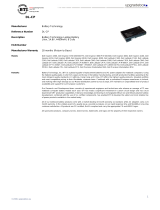l Depending on how you set the power management options in the Power Options Properties window or the QuickSet Power Management Wizard, use
one of the following methods:
¡ Press the power button.
¡ Close the display.
¡ Press <Fn><Esc>.
To exit standby mode, press the power button or open the display depending on how you set the power management options. You cannot make the computer
exit standby mode by pressing a key or touching the touch pad.
Hibernate Mode
Hibernate mode conserves power by copying system data to a reserved area on the hard drive and then completely turning off the computer. When the
computer exits hibernate mode, it returns to the same operating state it was in before entering hibernate mode.
Your computer enters hibernate mode if the battery charge level becomes critically low.
To manually enter hibernate mode:
l Click Start® Turn off computer, press and hold <Shift>, and then click Hibernate.
or
l Depending on how you set the power management options in the Power Options Properties window or the QuickSet Power Management Wizard, use
one of the following methods to enter hibernate mode:
¡ Press the power button.
¡ Close the display.
¡ Press <Fn><F1>.
To exit hibernate mode, press the power button. The computer may take a short time to exit hibernate mode. You cannot make the computer exit hibernate
mode by pressing a key or touching the touch pad. For more information on hibernate mode, see the documentation that came with your operating system.
Configuring Power Management Settings
You can use the QuickSet Power Management Wizard or Windows Power Options Properties to configure the power management settings on your computer.
l To access the QuickSet Power Management Wizard, double-click the icon in the taskbar. For more information about QuickSet, click the Help button
in the Power Management Wizard.
l To access the Power Options Properties window, click Start® Control Panel® Performance and Maintenance® Power Options. For information on
any field in the Power Options Properties window, click the question mark icon on the title bar and then click the area where you need information.
Charging the Battery
When you connect the computer to an electrical outlet or install a battery while the computer is connected to an electrical outlet, the computer checks the
battery charge and temperature. If necessary, the AC adapter then charges the battery and maintains the battery charge.
If the battery is hot from being used in your computer or being in a hot environment, the battery may not charge when you connect the computer to an
electrical outlet.
The battery is too hot to start charging if the light flashes alternately green and orange. Disconnect the computer from the electrical outlet and allow the
computer and the battery to cool to room temperature. Then connect the computer to an electrical outlet to continue charging the battery.
For more information about resolving problems with a battery, see Power Problems.
Replacing the Battery






















